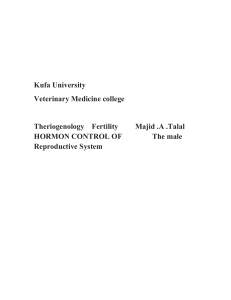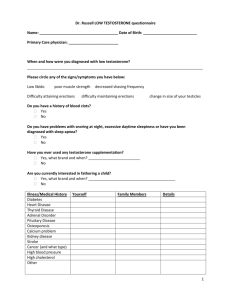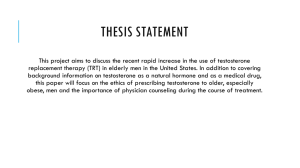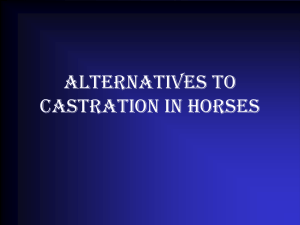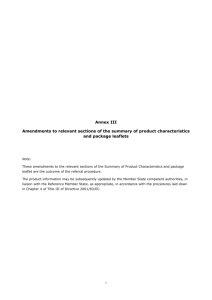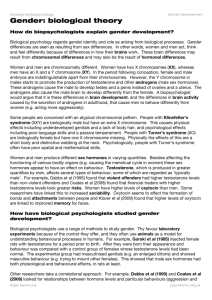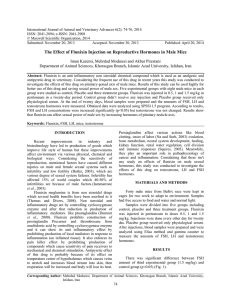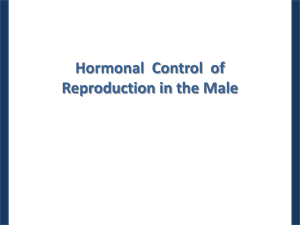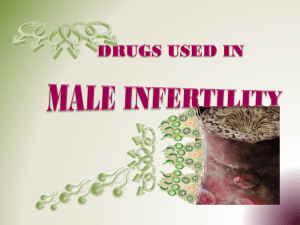Hormones
advertisement
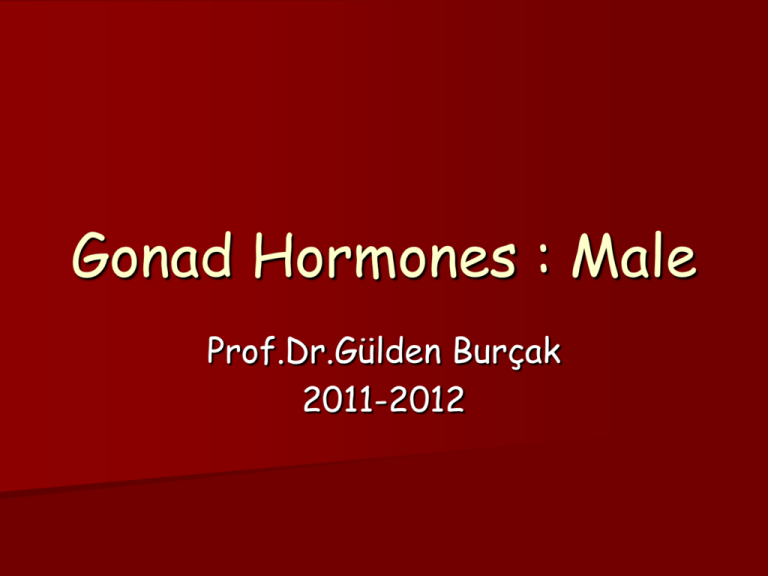
Gonad Hormones : Male Prof.Dr.Gülden Burçak 2011-2012 Testis male sex hormones male germ cells Testis : two functional units Semineferous tubules lined with Sertoli cells and germ cells (spermatogonia) for production and transport of sperm . Sertoli cells provide the environment necessary for germ cell differentiation and maturation Interstitial cells ( Leydig cells) for production of testosterone. Hypothalamic-Pituitary-Testis Axis Constant pulsatile release of GnRH from the hypothalamus Synthesis, storage and secretion of gonadotropins (FSH and LH) from the anterior pituitary (-)feedback relationship between the androgens and GnRH, FSH, LH secretions Prolonged exposure to LH results in desensitization In childhood testosterone and plasma gonadotropin levels are low HPA is highly sensitive to (-) feedback effects of gonadal steroids Onset of puberty Bursts of GnRH release Sleep associated surges in LH secretion and to a lesser extent in FSH secretion Later in puberty pulsatile gonadotropin secretion throughout the day and night and more sustained plasma gonadotropin, testosterone and dihydrotestosterone For normal testicular function, GnRH pulses occur at a frequency of 3.8 pulses every 6 hours. At a lower pulse rate FSH release ; at a higher pulse rate LH is more prominent Circulating half-life : FSH,4 hours ; LH, 30 minutes Testosterone : diurnal rythmic pattern, highest in the early morning LH binds Leydig cells testosterone synthesis and secretion secretion is inhibited by both testosterone and estradiol conversion of testosterone to estradiol in brain, pituitary and testes FSH binds Sertoli cells synthesis of androgen binding protein, aromatase enzyme complex, inhibin secretion is primarily inhibited by inhibin B but also by testosterone Testosterone biosynthesis Cholesterol de novo synthesis or from LDL cholesterol esters storage in cytoplasm LH (cAMP) (acute) : esterase activation and cholesterol transport to the inner mitochondrial membrane (steroidogenic acute regulatory protein (StAR) LH (cAMP) (chronic) : steroidogenic enzyme synthesis Side chain cleavage and removal of the six-carbon fragment Cytochrome P450 side chain cleavage Two hydroxylations first at C22 then at C20 (O2 and NADPH) Cholesterol 20,22- desmolase 5α-reductase,type I : liver Type II : reproductive tissues and peripheral targets Daily testicular production 5mg testosteron, 50-100μg DHT ; %25 of DHT in circulation %25 of estradiol (E2) in circulation Testosterone : a circulating precursor of DHT and E2 DHT (5α-reductase) in liver, kidney, muscle, prostate, external genitalia and genital skin E2 (aromatase enzyme complex) in muscle, liver, kidney, brain, adipose tissue. 50% loosely bound to albumin (> 400 mg /L) 45% bound with high affinity to SHBG 1-2% to CBG < % 4 is free The normal level of SHBG is about 30-50% lower in men than in women SHBG levels may be elevated in testosterone deficient men. A change in the level of SHBG causes a greater change in the free testosterone level than in the free estradiol level. Effects of androgens Sexual differentiation Spermatogenesis Development of secondary sexual organs Anabolic metabolism and gene regulation Male pattern behaviour Estradiol : sexual behavior and control of LH secretion Targets for testosterone Embryonic Wolffian structures, spermatogonia, muscles,bone, kidney and brain Targets for dihydrotestosterone Prostate, external genitalia and the genital skin The kidney is a major target tissue of the androgens : general enlargement of the kidney Excretory metabolites : inactive or less active Oxidation at the 17-position in many tissues, including the liver 17 ketosteroids : androsterone and etiocholanolone conjugated with glucuronide and sulfate Androstanediol Pathological States Primary hypogonadism Genetic disorders : Klinefelter’s syndrome Androgen receptor defects : Testicular feminization syndrome Inherited enzyme defects : 20,22-desmolase, 3ß-hydroxydehydrogenase,17α-hydroxylase 17,20 desmolase , 17-ketosteroid reductase Failure of the pituitary/hypothalamus to respond to low testosterone levels In hypogonadism Hypothalamus : Low GnRH ; low FSH,LH; low E2 /testosterone Pituitary : High GnRH ; low FSH,LH ; low E2 /testosterone Gonad : High GnRH ; high FSH,LH ; low E2 /testosterone Hyperprolactinemia is associated with diminished libido and impotence Hypergonadism Testicular hyperfunction : Testicular tumors (often produce hCG and αfetoprotein) Hypothalamic/pituitary hyperactivity usually from a tumor Benign prostatic hypertrophy : extensive and uncontrolled division of prostate cells Testosterone / dihydrotestosterone + estradiol Erectile dysfunction may occur secondarily to vascular problems associated with diabetes, atherosclerosis Infertility
